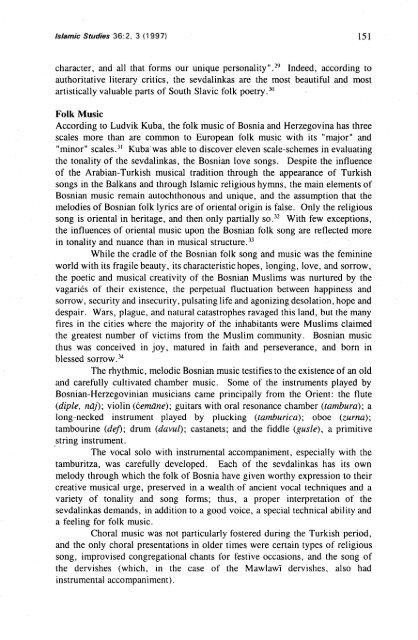You also want an ePaper? Increase the reach of your titles
YUMPU automatically turns print PDFs into web optimized ePapers that Google loves.
Islamic Studies 36:2, 3 (1 997) 151<br />
character, and all that forms our unique pers~nality".'~ Indeed, according to<br />
authoritative literary critics, the sevdalinkas are the most beautiful and most<br />
artistically valuable parts of South Slavic folk poetry.30<br />
Folk Music<br />
According to Ludvik Kuba, the folk music of Bosnia and Herzegovina has three<br />
scales more than are common to European folk music with its "major" and<br />
"minor" scale^.^' Kuba was able to discover eleven scale-schemes in evaluating<br />
the tonality of the sevdalinkas, the Bosnian love songs. Despite the intluence<br />
of the Arabian-Turkish musical tradition through the appearance of Turkish<br />
songs in the Balkans and through Islamic religious hymns, the main elements of<br />
Bosnian music remain autochthonous and unique, and the assumption that the<br />
melodies of Bosnian folk lyrics are of oriental origin is false. Only the religious<br />
song is oriental in heritage, and then only partially so.32 With few exceptions,<br />
the influences of oriental music upon the Bosnian folk song are retlected more<br />
in tonality and nuance than in musical structure."<br />
While the cradle of the Bosnian folk song and music was the feminine<br />
world with its fragile beauty, its characteristic hopes, longing, love, and sorrow,<br />
the poetic and musical creativity of the Bosnian Muslims was nurtured by the<br />
vagariCs of their existence, the perpetual fluctuation between happiness and<br />
sorrow, security and insecurity, pulsating life and agonizing desolation, hope and<br />
despair. Wars, plague, and natural catastrophes ravaged this land, but the many<br />
fires in the cities where the majority of the inhabitants were Muslims claimed<br />
the greatest number of victims from the Muslim community. Bosnian music<br />
thus was conceived in joy, matured in faith and perseverance, and born in<br />
blessed sorrow.34<br />
The rhythmic, melodic Bosnian music testifies to the existence of an old<br />
and carefully cultivated chamber music. Some of the instruments played by<br />
Bosnian-Herzegovinian musicians came principally from the Orient: the tlute<br />
(diple, naj); violin (Cemane); guitars with oral resonance chamber (tambura); a<br />
long-necked instrument played by plucking (tamburica); oboe (zurna);<br />
tambourine (def); drum (davul); castanets; and the fiddle (gusle), a primitive<br />
string instrument.<br />
The vocal solo with instrumental accompaniment, especially with the<br />
tamburitza, was carefully developed. Each of the sevdalinkas has its own<br />
melody through which the folk of Bosnia have given worthy expression to their<br />
creative musical urge, preserved in a wealth of ancient vocal techniques and a<br />
variety of tonality and song forms; thus, a proper interpretation of the<br />
sevdalinkas demands, in addition to a good voice, a special technical ability and<br />
a feeling for folk music.<br />
Choral music was not particularly fostered during the Turkish period,<br />
and the only choral presentations in older times were certain types of religious<br />
song, improvised congregational chants for festive occasions, and the song of<br />
the dervishes (which, In the case of the Mawlawi dervishes, also had<br />
instrumental accompaniment).
















